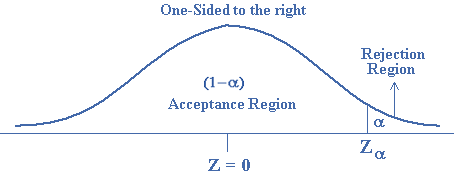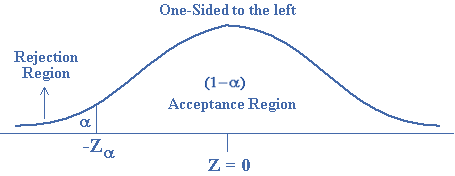One-Tailed Test
When the alternative hypothesis $${H_1}$$ is one-sided like $$\theta > {\theta _o}$$ or $$\theta < {\theta _o}$$, then the rejection region is taken only on one side of the sampling distribution. This is called a one-tailed test or one-sided test. When $${H_1}$$ is one-sided to the right like $$\theta > {\theta _o}$$, the entire rejection region equal to $$\alpha $$ is taken in the right end of the sampling distribution.
Here the test is called one-sided to the right. The hypothesis $${H_o}$$ is rejected if the calculated value of a statistic, say $$Z$$, falls in the rejection region. The critical value is $${Z_\alpha }$$ which has the area equal to $$\alpha $$ to its right. The rejection region and acceptance region are shown in the figure below. The null hypothesis $${H_o}$$ is rejected when $$Z$$ (calculated) $$ > {Z_\alpha }$$.

If the alternative hypothesis is one-sided to the left like $$\theta < {\theta _o}$$, the entire rejection region equal to $$\alpha $$ is taken on the left tail of the sampling distribution. The test is called one-sided or one-tailed to the left. The critical value is $$ – {Z_\alpha }$$, which cuts off the area equal to $$\alpha $$ to its left. The critical region is $$Z < – {Z_\alpha }$$ and is shown in the figure below.

For some important values of $$\alpha $$, the critical values of $$Z$$ for two-tailed and one tailed tests are given below:
Critical Value of $$Z$$
|
$$\alpha $$
|
Two-sided test
|
One-sided test
|
One-sided to the left
|
|
$$0.10{\text{ }}(10\% )$$
|
$$ – 1.645$$and $$ + 1.645$$
|
$$ + 1.282$$
|
$$ – 1.282$$
|
|
$$0.05{\text{ }}(5\% )$$
|
$$ – 1.96$$and $$ + 1.96$$
|
$$ + 1.645$$
|
$$ – 1.645$$
|
|
$$0.02{\text{ }}(2\% )$$
|
$$ – 2.326$$and $$ + 2.326$$
|
$$ + 2.054$$
|
$$ – 2.054$$
|
|
$$0.01{\text{ }}(1\% )$$
|
$$ – 2.575$$and $$ + 2.575$$
|
$$ + 2.326$$
|
$$ – 2.326$$
|
